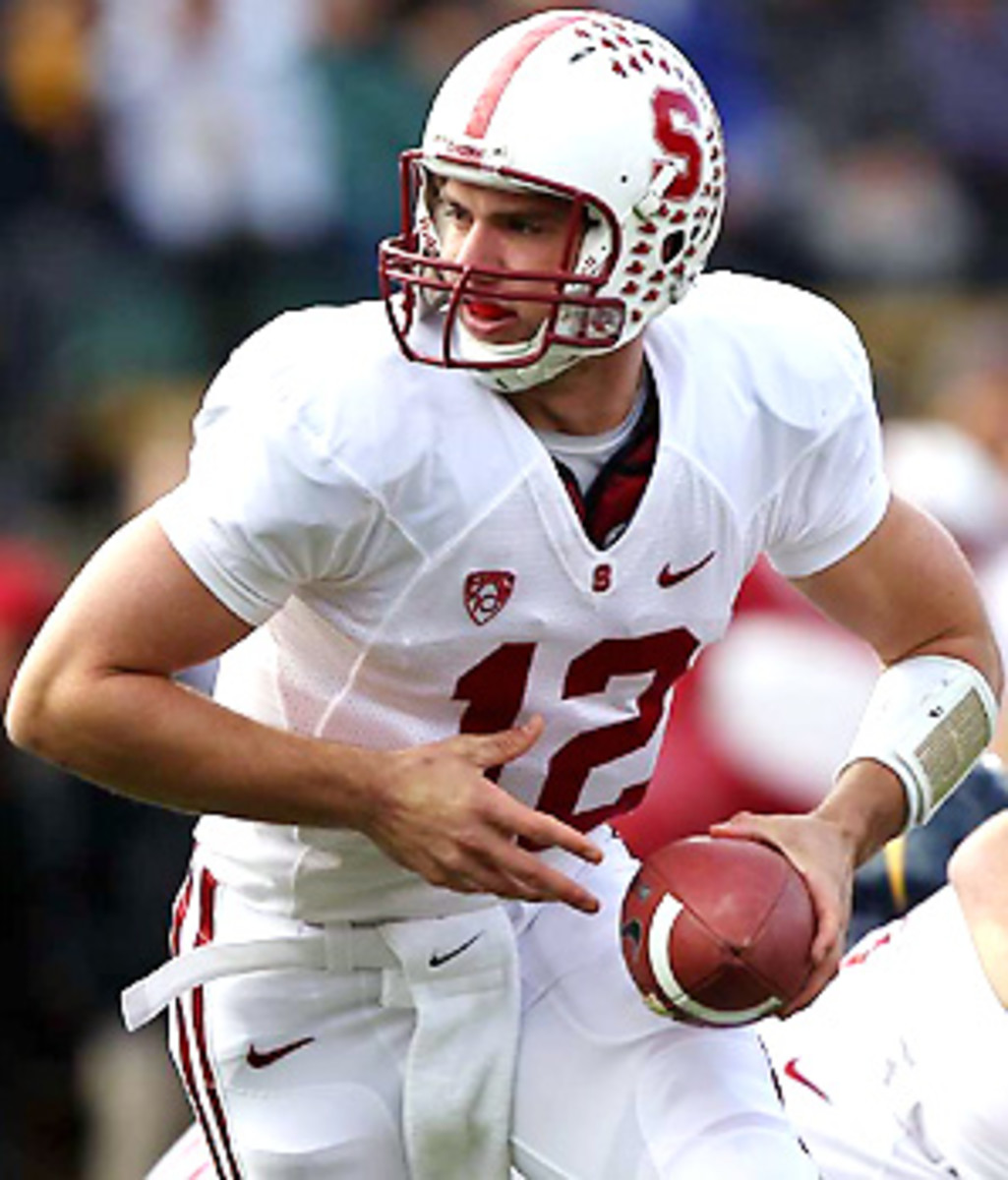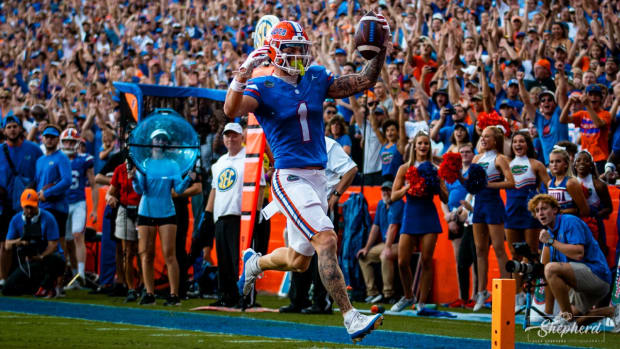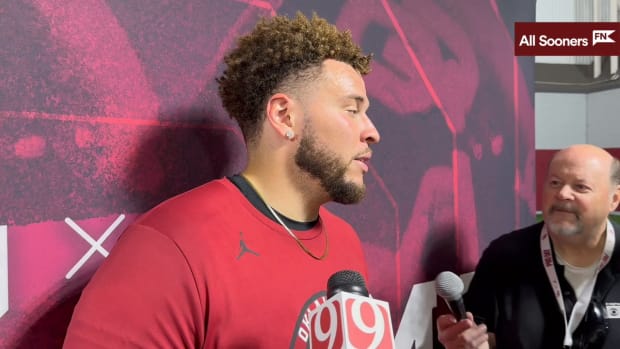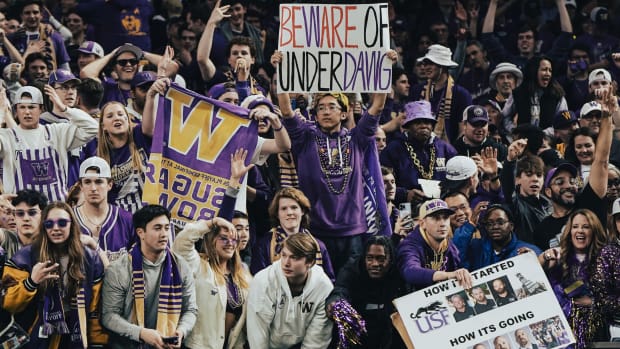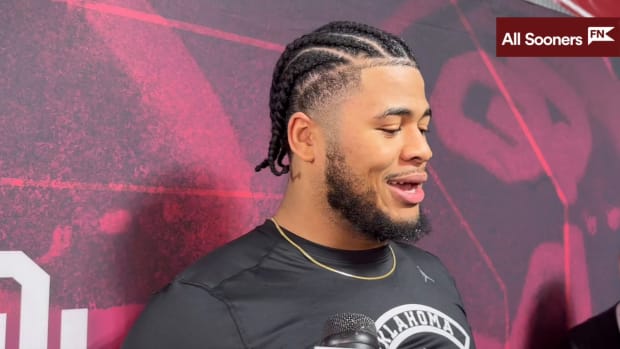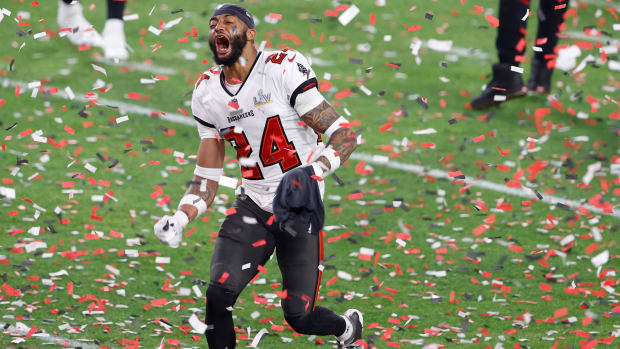Ten reasons to embrace college football after a year of scandal
The first eight months of 2011 have not been pleasant for college football enthusiasts. One of the sport's most accomplished coaches resigned in disgrace. One of the four most prestigious bowl games was embroiled in corporate fraud. NCAA investigations hovered over both schools that participated in last season's BCS championship game and a host of other high-profile programs. At conference media days, commissioners' speeches about full-cost scholarships and stiffer sanctions drowned out the usual anticipatory chatter about the upcoming season.
So with fall camps in full swing and opening kickoff a mere three weeks away, it's time for the college football world to stop and press the reset button. While the issues plaguing the sport aren't going away, it's worth reminding ourselves that nearly all the recent scandals -- the tattoos, the agents, the bowl junkets and the cover-ups -- were indictments of the system, not the sport. Strip away the commercialism and the corruption and nearly all the same components that made fans fall in love with this crazy game to begin with remain.
And they'll be on full display yet again during the 2011 season.
At its core, college football is about the connection between the actors on the field and the devotees who watch them. There's something more than zone reads and blitz schemes at work when millions of people choose to spend their Saturdays firing up the grill nine hours before kickoff or working their remote from the couch. Certain elements of our love affair with college football remain impervious to NCAA bylaws and bloated television contracts.
Here, we celebrate a refreshingly gifted quarterback who holds the same affinity for college as for football; a treasured tradition that refuses to die; an iconic coach who transcends multiple generations. Even modern twists like a pair of expanded conferences and an innovative new head coach represent the latest incarnations of more timeless themes.
The 2011 season is upon us. Peer out from behind the stain to find four months of invigorating stories. Here are 10 reasons to embrace college football in 2011.
College football is still played by actual college students, though saying that usually elicits eye rolls. Each year, conferences and other organizations announce various all-academic teams that garner almost no attention. But even the most hardened cynic would have a hard time disputing the fact that the sport's biggest name in 2011 -- a Heisman front-runner and projected No. 1 draft pick -- takes his course reading as seriously as his hot reads.
Andrew Luck is the quarterback at Stanford, which in and of itself requires a certain academic aptitude. But when the Houston native put off the NFL last winter to come back for another season, he did so for more than just another shot at a BCS bowl. He came back to finish his degree in architectural design, which last spring included presenting a design for the school's planned 90,000-square foot arts center. "This is a special place no matter how the football team is doing," Luck said. "It's exciting to go to school here."
The somewhat goofy, mild-mannered 21-year-old grew a farcically long beard over the summer (though sadly trimmed it shortly after Pac-12 Media Day) and is often described as "just a regular guy." That may seem corny to some and hard to believe to others, but Stanford first-year head coach David Shaw says it's true.
"We're so used to great stories being written about guys that end up not being what people said they were," said the Cardinal's former offensive coordinator who replaces Jim Harbaugh. "I often run into people who have run into Andrew and the first thing they said to me is, 'Gosh all the stories are true.' He's humble, he's genuine, he's a good kid. He's a great ambassador for college football."
Nothing excites a downtrodden fan base more than the dream of a freshman who can step on campus and change the direction of the program. This year, new Texas Longhorn Malcolm Brown is that freshman. The 6-foot, 215-pound tailback from Cibolo, Texas, probably will generate more discussion in the Lone Star State this month than Gov. Rick Perry's potential presidential run. (But maybe that's only because Perry is an Aggie.) Of course, that's what happens when the wealthiest program in America -- with the easiest natural recruiting advantage -- goes 5-7 the season prior.
Brown's highlight reel from Steele High looks like a burnt orange dream come true. A big back who lines up behind the quarterback and hits the hole with extreme prejudice before bludgeoning a would-be tackler on the second level? Where have folks in Austin seen that before? Maybe from Cedric Benson? Maybe from Ricky Williams? Maybe from -- gasp -- Earl Campbell?
See how easily people can get ahead of themselves? The kid hasn't even played a college down. But what's the fun in waiting? The Longhorns have pined for a dominant back since the running game was ceded to the quarterback for the Vince Young and Colt McCoy eras. Maybe Brown is that player. At Boise State, Bryan Harsin helped turn lightly recruited Doug Martin into one of the nation's best backs. Harsin, now the co-offensive coordinator at Texas, will have a chance to design plays for Brown.
Still, Brown can't do it all on his own even if he winds up being a cross between Jim Brown and Walter Payton. The line will have to block better and the quarterbacks will have to stop throwing interceptions. But if Brown is as good as advertised, he may be the most visible piece of the offseason overhaul in Austin. If Brown doesn't live up to the hype, there's always 2012. That's when the next, next great Texas back, Johnathan Gray of Aledo, will make his Longhorns debut.
"Championship Saturday" first made its way into the college football lexicon on Dec. 5, 1998, when, on the final day of the regular season, Miami knocked off undefeated UCLA (in a game postponed from September due to a hurricane) and Texas A&M shocked undefeated Kansas State in the Big 12 title game, crushing the Bruins' and Wildcats' national-championship aspirations. (No. 1 Tennessee survived its SEC title bout with Mississippi State.) Since then, the first Saturday in December has provided no shortage of drama, from K-State's stunning blowout of previously untouchable Oklahoma in 2003, to Florida's improbable ascension to No. 2 in 2006 when its SEC title victory coincided with a USC upset loss to UCLA, to the mass chaos of both No. 1 Missouri and No. 2 West Virginia going down in 2007.
The day always felt incomplete, however, due to the prestigious Big Ten traditionally closing shop after Thanksgiving. Finally, the conference of Woody and Bo is staging its own neutral-site spectacle in Indianapolis. With the league's rabid fan interest and a central locale, it could eventually come to rival the SEC's wildly successful 20-year-old event. (This year's game sold out in two hours.) "With our fan base in the Big Ten, that's going to be like the Super Bowl the first week of December," said Indiana coach Kevin Wilson.
Meanwhile, the newly expanded Pac-12 -- which had already begun pushing games to December -- is putting its own spin on a conference championship game by playing in the higher-finishing team's home stadium. At a minimum, both leagues' Rose Bowl berths will be decided in winner-takes-all fashion; a BCS title-game spot could be on the line.
And for those who prefer a good-old fashioned round-robin champion, the Big 12's got it covered. When the league decreased from 12 to 10 teams last year, it ditched its title game and introduced a nine-game conference schedule. Not that it won't be heard from in December; the league moved the Oklahoma-Oklahoma State Bedlam Game to Championship Saturday.
Now it's complete.
Alabama opens the season Sept. 3 against Kent State, and rarely has a paycheck game meant so much. There is little doubt that the Crimson Tide will destroy the Golden Flashes. But for the city of Tuscaloosa, the game will offer another chance to heal from the devastation wrought by the April tornado that wiped out homes, businesses and lives.
Football means more in Tuscaloosa than it does just about anywhere else, and the Kent State game gives residents -- many of whom are still trying to rebuild their lives -- a reason to come together and cheer after months of struggling. When Bear Bryant's voice growls through the speakers at Bryant-Denny Stadium, the roar might match the decibel level after a last-second win in a critical SEC game. The offseason in Tuscaloosa has been long and painful. Football will help make life normal again.
The game will provide only a brief respite for those still dealing with the tornado's aftermath. The news cycle has continued to spin, but there is still much work to do in Tuscaloosa. For information on how to help, check out Givetuscaloosa.com or call (205) 758-7588.
If no one answers Sept. 3, don't be shocked. They're probably cheering on the Crimson Tide.
Forgive Utah receiver Reggie Dunn if he's a little amped up before the Utes' first Pac-12 game Sept. 10 at USC. "I'm not lying, I get the chills every time I see it on the schedule," said Dunn, a Los Angeles native whose South Central high school sits less than 10 miles from the L.A. Coliseum. "I hope [the game] will last forever." Dunn is one of nearly 30 native Californians who came to Salt Lake assuming they'd be spending their careers in the lesser-regarded Mountain West. Many went unrecruited by major-conference schools; others, like Dunn, may have wound up in the Pac-12 under different circumstances (he committed to Oregon State out of high school before enrolling in junior college). Now they're getting their shot.
"It's a culmination of a lot of hard work," said Utah coach Kyle Whittingham, a staff member since 1994, when the school was in the WAC. Two BCS bowl victories later, Whittingham's program has achieved a dream many would have deemed unfathomable before Urban Meyer and Alex Smith arrived on the scene a few years back. College football's subjective method for determining its champion does not allow for a whole lot of Butler or George Mason-type moments. Boise State's dramatic Fiesta Bowl victory over Oklahoma five years ago was as close as it gets. Fans embrace the occasional Appalachian State-model Cinderella, but not if Cinderella actually poses a threat to the ever-territorial BCS race, as Boise State found out last year amid a flurry of backlash.
Now, Utah can pursue all the same goals as an Alabama or a Texas free from the artificial ceiling and dismissive arguments that hover over teams outside the six BCS conferences. On behalf of Boise State, TCU (which joins the Big East next season), et. al., this is the definitive chance to win over the doubters. "To me, we're underdogs," said Dunn. "For a school like us, moving to a [major] conference, we have to prove ourselves. Hopefully it will give other schools like us a chance."
Don't get us wrong. Nick Saban is a wonderful coach. His success is undeniable, and because of this success, Saban's coaching spawn will someday overrun college football. Sportswriters will devise a shortcut key to type the word "process." That's all well and good, but the game is more fun when the coach looks as if he's also having fun.
Enter Dana Holgorsen at West Virginia. How did the Mike Leach acolyte celebrate his ascension to head coach after the Bill Stewart/Deep Throat affair? He went sky diving. Earlier, Holgorsen made headlines for his ejection from a casino. That's not so good, but it suggests Holgorsen will be interesting at a time when head coaches go out of their way to be boring.
Holgorsen, who always looks like he's headed to a party, should be quite intriguing on the field. He inherited quarterback Brandon Weeden and receiver Justin Blackmon last year at Oklahoma State and cranked up the Cowboys' offense into a juggernaut that ranked third in the nation in total offense (520.2 yards per game) and scoring offense (44.2 points per game). This year, he inherits quarterback Geno Smith and a stable of good receivers. If Holgorsen works the same magic he worked as a coordinator at Texas Tech, Houston and Oklahoma State, the Mountaineers should torch the rest of the Big East.
On Nov. 18, 2006, No. 1 Ohio State beat No. 2 Michigan 42-39 in a game that drew as much national attention as any in that fabled rivalry's century-plus history. Since then the rivalry has pretty much fallen off the map. Jim Tressel's Buckeyes beat the Wolverines seven straight times, including three straight blowouts during the short-lived tenure of maligned Michigan coach Rich Rodriguez.
Enter Brady Hoke. The 52-year-old former defensive line coach (including on Michigan's 1997 national championship team) takes the rivalry with his home-state school (he's from Dayton) pretty seriously. He never calls Ohio State by its full name, referring to it only as "Ohio." He's long refused to wear red, even while leading two teams (Ball State and San Diego State) with red as their primary color, instead opting for black. He's also the kind of guy who says, "This might sound arrogant, and if it is, it is. We're Michigan."
Think this guy might get under some peoples' skin?
Hoke's arrival in Ann Arbor happens to coincide with Tressel's abrupt demise in Columbus. The man who owned Michigan for a decade is no more. It's far too early to say whether Hoke will fare better against Luke Fickell than Lloyd Carr and Rodriguez did against Tressel. The talent gap between the two teams on display last November (a 37-7 Ohio State victory) will presumably take more than one recruiting calendar to change. But whatever the case, one of college football's most cherished rivalries just got a lot more interesting -- and that's a good thing no matter which color you wear.
Auburn has to replace a lot from the team that won last year's national title, but the Tigers have plenty of young talent. So every time they win, Auburn fans, go to the corner of College and Magnolia and hurl your Charmin like it's the last time you'll ever get to do it. Because this could be the final season for a tradition in its sixth decade.
Someone poisoned the trees in December, and an Alabama fan named Harvey Updyke is scheduled to stand trial for the crime in October. Don't worry about Updyke. Worry about football and toilet paper. After determining the trees can't get much sicker, Auburn officials decided to allow fans to roll the trees this season. The horticulture experts on campus still hold out hope of saving the trees, but they aren't optimistic. By spring 2012, they should know the ultimate fate of the trees.
Auburn officials have solicited ideas for ways to preserve the tradition even if the trees die, but the trees are the tradition. Fathers have rolled with sons and grandsons. Something new will come along, and fans eventually will embrace it, but a true, organic tradition can't be replaced with a concept formulated by a steering committee.
So head to the store, Auburn fans, and empty the shelves of quilted Northern. Warm up your arms. When the Tigers win, throw. Throw for all the memories made under those branches, and throw for all the people who might never know the joy of rolling Toomer's Corner.
We watch sports to be entertained, but also for those moments of utter amazement. For earlier generations, that meant watching Red Grange score four touchdowns in 12 minutes against Michigan or Jim Brown leaving defenders in his dust. More than a half-century later we still get to witness new, jaw-dropping feats, be it Vince Young's one-man Rose Bowl domination, Tim Tebow's jump passes or Cam Newton's machine-gun sprint through the LSU defense. As players' athleticism continually increases, so too does the realm of possibilities.
In today's increasingly pass-heavy game, some of the most gifted athletes on the field are the guys catching the ball, and this season's position group looks to be particularly rich. Oklahoma State's Justin Blackmon, the 2010 Biletnikoff winner, and Oklahoma's Ryan Broyles both posted staggering numbers last season: Blackmon made 111 catches for 1,782 yards and 20 touchdowns while Broyles caught 131 balls for 1,622 yards and 14 scores. Both could have easily gone pro, but returned for another season to grace us with highlights like this and this.
Elite receivers are hardly limited to the state of Oklahoma, though. They can also be found in Tucson, Ariz. (Arizona's Juron Criner), Los Angeles (USC's Robert Woods) and College Station, Texas (A&M's Jeff Fuller).
Then there's South Carolina's Alshon Jeffery, the 6-4, 229-pound NFL prototype who may well be the best of the bunch. As a sophomore, he had 88 catches for 1,517 yards, including a 192-yard day against eventual BCS champion Auburn. He can also do this. "He just has a dominant presence about him," his position coach, Steve Spurrier Jr., told SI.com. "He has natural coordination and skill, and when the ball is in the air, no one can get around him to make a play." The size, the vision and the footwork are attributes most of us can only dream of. And that's precisely why we watch.
This section might have said something different, but on the day before this piece was scheduled to run, news broke that Penn State coach Joe Paterno had been injured at practice Sunday when he was blindsided by a receiver. Immediately, the masses wondered, "Is this it for JoePa?" A day later, Paterno ran his coaches meeting via speakerphone from the hospital. Paterno also provided this gem to spokesman Jeff Nelson: "I expect to be back at practice soon," Paterno said. "I'm doing fine; tell everyone not to worry about me."
Paterno turns 85 on Dec. 21. His contract expires after this season. At Big Ten media day, he said this. "Right now, I'm looking at four or five years," Paterno said. "That may be optimistic. I don't know."
The man wants to coach until he's 90. If we're lucky, he will.
